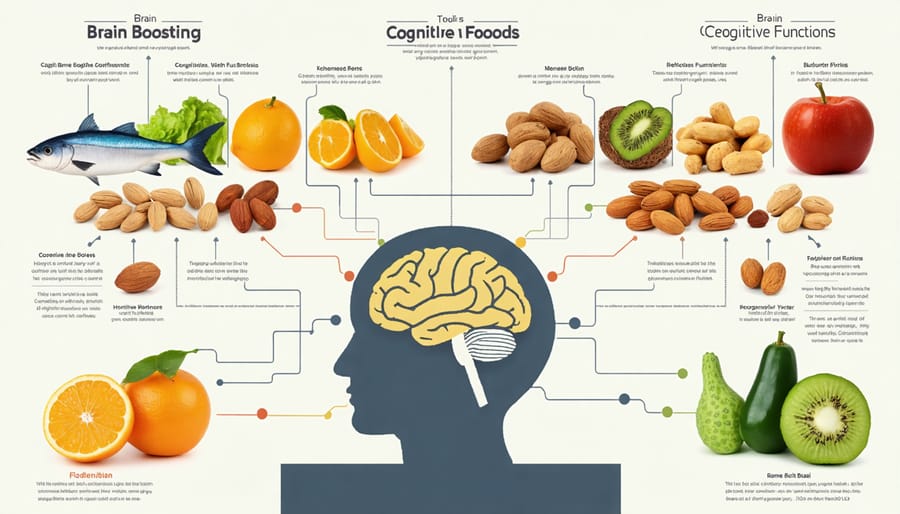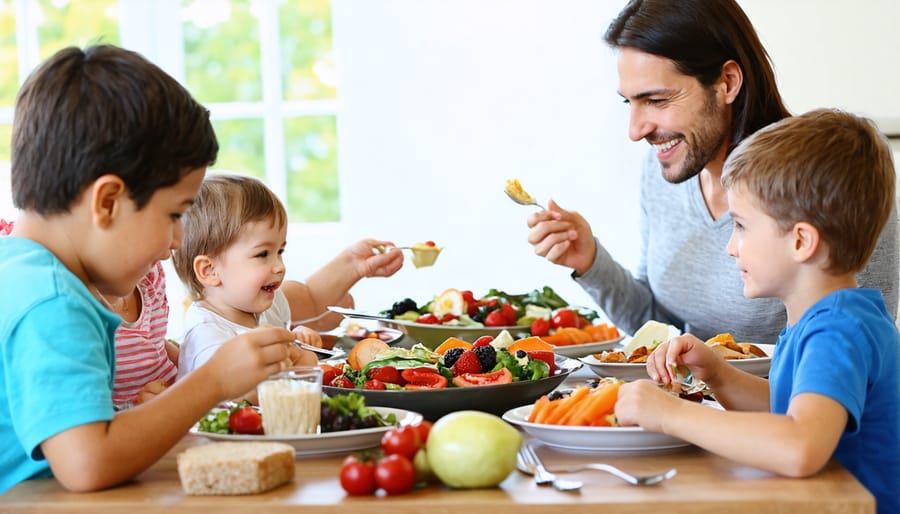Transform your family’s relationship with food by practicing mindful eating habits that nourish both body and mind. Recent research reveals that children who develop a conscious connection to their food choices show improved focus, better emotional regulation, and healthier eating patterns throughout life.
Picture mealtimes as opportunities for discovery rather than battles over vegetables. When families eat together mindfully – without screens, rushing, or judgment – children naturally develop better awareness of hunger cues and food preferences. This awareness becomes their foundation for lifelong healthy choices.
The mind-body connection through nutrition isn’t just about what we eat, but how we eat it. Teaching children to notice texture, taste, and satisfaction helps them develop an intuitive understanding of nourishment that goes beyond counting calories or following rigid rules. This gentle, awareness-based approach supports both physical health and emotional wellbeing, creating a positive food environment that can benefit the entire family.
By focusing on the experience of eating rather than restrictive food rules, we open the door to better nutrition naturally. This mindful approach helps children develop a healthy, sustainable relationship with food that can last a lifetime.
The Brain-Food Connection in Child Development
Key Nutrients for Mental Wellness
Just as a balanced diet helps to support child development, specific nutrients play crucial roles in maintaining mental wellness. Let’s explore the key nutrients that contribute to emotional balance and cognitive health.
Omega-3 fatty acids, found in fatty fish, walnuts, and flaxseeds, are essential for brain development and emotional regulation. These healthy fats help build and maintain brain cell membranes, supporting better communication between neurons.
B vitamins, particularly B12 and folate, are vital for producing mood-regulating neurotransmitters. Include plenty of whole grains, leafy greens, and legumes in your family’s meals to ensure adequate intake of these important nutrients.
Zinc and magnesium work together to support emotional stability and healthy stress responses. Foods rich in these minerals include pumpkin seeds, yogurt, and whole grains. Many parents have noticed improvements in their children’s mood and focus when ensuring regular intake of these nutrients.
Vitamin D, often called the “sunshine vitamin,” plays a crucial role in mood regulation. While our bodies can produce it through sun exposure, many children may need additional sources through diet or supplements, especially during winter months.
Protein provides the building blocks for neurotransmitters that regulate mood and behavior. Including quality protein sources like eggs, lean meats, beans, and nuts helps maintain stable energy levels and emotional balance throughout the day.
Remember, these nutrients work best when consumed as part of a varied, wholesome diet rather than in isolation. Always consult with your healthcare provider before making significant changes to your child’s diet or adding supplements.

The Impact of Food Choices on Mood
The foods we serve our children do more than just fill their bellies – they can significantly influence their mood, behavior, and overall emotional well-being. As Sarah Thompson, a pediatric nutritionist, often reminds parents, “What we feed our children today shapes how they feel and act tomorrow.”
Research shows that balanced meals rich in whole grains, lean proteins, and colorful fruits and vegetables help maintain stable blood sugar levels, which is crucial for consistent mood and energy throughout the day. When children experience blood sugar spikes and crashes from sugary foods or irregular eating patterns, it can lead to irritability, difficulty concentrating, and emotional outbursts.
Certain nutrients play key roles in emotional regulation. For example, omega-3 fatty acids found in fish, nuts, and seeds support brain health and have been linked to reduced anxiety in children. Foods rich in B vitamins, like whole grains and legumes, help produce neurotransmitters that regulate mood. Meanwhile, processed foods high in artificial additives and refined sugars may contribute to hyperactivity and mood swings in some children.
One mother, Jennifer, noticed a remarkable change in her 7-year-old’s behavior after reducing processed snacks and incorporating more whole foods into his diet. “The afternoon meltdowns decreased significantly, and his teachers reported better focus in class,” she shares.
It’s important to remember that every child is different, and food choices should be approached with flexibility and understanding. Small, gradual changes often work better than dramatic dietary overhauls. Creating positive associations with healthy foods through family meals and involving children in food preparation can help establish lasting healthy eating habits that support emotional well-being.
Creating Mindful Eating Habits

Family Mealtime Rituals
Creating positive mealtime experiences starts with establishing consistent family rituals around meals. Turn off televisions and put away phones to create a distraction-free environment where meaningful conversations can flourish. Try to eat at roughly the same times each day, giving everyone a sense of routine and predictability.
Make mealtimes interactive by involving children in age-appropriate food preparation tasks. Even young children can help set the table or wash vegetables, fostering a connection to the food they’ll be eating. This engagement naturally promotes mindfulness and curiosity about different foods.
Start meals with a moment of gratitude or a simple breathing exercise. This can be as simple as taking three deep breaths together or sharing one thing you’re thankful for. These small practices help everyone transition into a more present state of mind.
Consider implementing the “one bite rule” instead of forcing children to clean their plates. This approach encourages exploration without pressure, allowing children to develop a healthy relationship with food at their own pace. Remember to model mindful eating behaviors yourself – children learn by watching how adults approach their meals.
Create a warm atmosphere by sharing stories about your day or playing simple table games like “I Spy” between bites. These interactions make mealtimes something to look forward to rather than just another daily task.
Teaching Food Awareness
Teaching children to understand their body’s signals and develop healthy relationships with food starts with open communication and mindful practices. Begin by encouraging children to pause before eating and check in with their hunger levels. You might use a simple scale, like “empty,” “just right,” or “very full,” to help them identify and express these feelings.
Create opportunities for children to engage with food positively through gardening, cooking together, or exploring new ingredients through sensory activities. When children participate in meal preparation, they develop a deeper connection to their food and better understand where it comes from.
Listen without judgment when children express their food preferences or feelings about eating. Avoid labeling foods as “good” or “bad,” instead focusing on how different foods make their bodies feel. For instance, you might say, “This apple gives us energy to play” rather than “Sweets are bad for you.”
Meal times should be relaxed and social experiences. Turn off screens and create a calm environment where children can focus on eating and family conversation. Remember that children naturally vary in their eating patterns – some days they may eat more, others less, and that’s perfectly normal.
Model mindful eating behaviors yourself by listening to your own hunger cues and speaking positively about food and body image. Children learn by example, and your relationship with food significantly influences their developing attitudes.
Overcoming Common Challenges

Dealing with Picky Eaters
Dealing with picky eating requires patience, understanding, and a gentle approach. Remember that food preferences develop gradually, and forcing children to eat can create negative associations with mealtimes. Instead, focus on making food exploration fun and pressure-free.
Start by offering new foods alongside familiar favorites, allowing children to observe, touch, and smell before tasting. Lead by example by showing enthusiasm for diverse foods during family meals. Small portions can make new foods less overwhelming – even a single pea counts as exposure!
Create positive mealtime experiences by engaging children in age-appropriate food preparation, gardening, or grocery shopping. This builds curiosity and ownership over food choices. Consider the “one bite rule” where children agree to try just one small taste, knowing they can politely decline after.
Praise effort rather than outcomes: “I’m proud of you for trying that cucumber!” instead of “Good job eating everything!” Remember that it can take 10-15 exposures before accepting a new food. Stay consistent and calm, and celebrate small victories in your child’s food journey.
Remember, every child’s journey with food is unique. Focus on progress, not perfection, and maintain a supportive environment where all food experiences are learning opportunities.
Managing Food-Related Anxiety
Food-related anxiety in children can manifest in various ways, from refusing to try new foods to experiencing stress during mealtimes. As parents and caregivers, it’s essential to approach these challenges with patience and understanding. Start by creating a calm, pressure-free environment during meals, where children feel safe to explore foods at their own pace.
Consider implementing the “one bite” rule, where children are gently encouraged to try a tiny taste of new foods without being forced to finish their plate. This approach helps build confidence while respecting their boundaries. Remember that it’s normal for children to need multiple exposures to new foods before accepting them.
If your child shows signs of significant food anxiety, such as becoming visibly distressed at mealtimes or displaying rigid eating patterns, consider keeping a food diary to identify triggers. This can help you work together to develop coping strategies. Some effective techniques include involving children in meal planning and preparation, using positive language around food, and modeling healthy eating behaviors yourself.
For persistent concerns, don’t hesitate to consult with a pediatric nutritionist or mental health professional who specializes in childhood eating behaviors. They can provide specialized strategies tailored to your child’s needs while ensuring both their nutritional and emotional well-being.
Mindful nutrition is a journey that can transform your family’s relationship with food and support your children’s mental well-being. By implementing small, consistent changes – like eating together without distractions, involving kids in meal preparation, and practicing gratitude for our food – we can create lasting positive habits. Remember that perfection isn’t the goal; what matters is making conscious choices that work for your family. Start with one or two practices that feel manageable, and gradually build from there. As you embrace mindful nutrition, you’ll likely notice improvements in your children’s mood, behavior, and overall connection to healthy eating. Your efforts to nurture both their bodies and minds through mindful nutrition will help set the foundation for lifelong healthy habits. Take that first step today – your family’s wellness journey begins with a single mindful meal.




